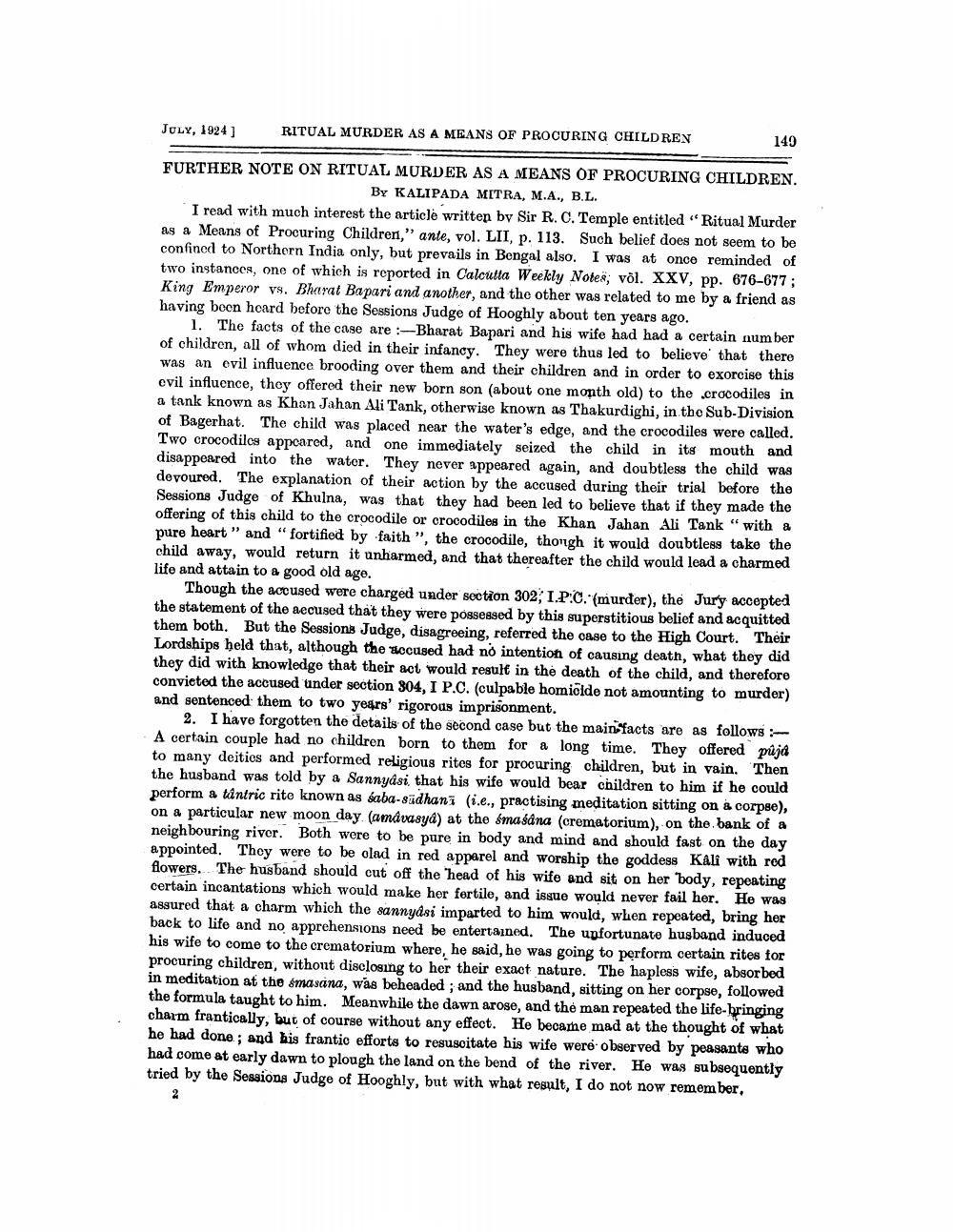________________
RITUAL MURDER AS A MEANS OF PROCURING CHILDREN
FURTHER NOTE ON RITUAL MURDER AS A MEANS OF PROCURING CHILDREN. BY KALIPADA MITRA, M.A., B.L.
I read with much interest the article written by Sir R. C. Temple entitled "Ritual Murder as a Means of Procuring Children," ante, vol. LII, p. 113. Such belief does not seem to be confined to Northern India only, but prevails in Bengal also. I was at once reminded of two instances, one of which is reported in Calcutta Weekly Notes; vòl. XXV, pp. 676-677; King Emperor vs. Bharat Bapari and another, and the other was related to me by a friend as having been heard before the Sessions Judge of Hooghly about ten years ago.
1. The facts of the case are :-Bharat Bapari and his wife had had a certain number of children, all of whom died in their infancy. They were thus led to believe that there was an evil influence brooding over them and their children and in order to exorcise this evil influence, they offered their new born son (about one month old) to the crocodiles in a tank known as Khan Jahan Ali Tank, otherwise known as Thakurdighi, in the Sub-Division of Bagerhat. The child was placed near the water's edge, and the crocodiles were called. Two crocodiles appeared, and one immediately seized the child in its mouth and disappeared into the water. They never appeared again, and doubtless the child was devoured. The explanation of their action by the accused during their trial before the Sessions Judge of Khulna, was that they had been led to believe that if they made the offering of this child to the crocodile or crocodiles in the Khan Jahan Ali Tank "with a pure heart" and "fortified by faith", the crocodile, though it would doubtless take the child away, would return it unharmed, and that thereafter the child would lead a charmed life and attain to a good old age.
JULY, 1924]
149
Though the accused were charged under section 302; I.P.C. (murder), the Jury accepted the statement of the accused that they were possessed by this superstitious belief and acquitted them both. But the Sessions Judge, disagreeing, referred the case to the High Court. Their Lordships held that, although the accused had no intention of causing death, what they did they did with knowledge that their act would result in the death of the child, and therefore convicted the accused under section 304, I P.C. (culpable homicide not amounting to murder) and sentenced them to two years' rigorous imprisonment.
2. I have forgotten the details of the second case but the main facts are as follows:A certain couple had no children born to them for a long time. They offered puja to many deities and performed religious rites for procuring children, but in vain. Then the husband was told by a Sannyasi that his wife would bear children to him if he could perform a tantric rite known as saba-sidhani (i.e., practising meditation sitting on a corpse), on a particular new moon day (amavasya) at the śmaśâna (crematorium), on the bank of a neighbouring river. Both were to be pure in body and mind and should fast on the day appointed. They were to be clad in red apparel and worship the goddess Kâlî with red flowers. The husband should cut off the head of his wife and sit on her body, repeating certain incantations which would make her fertile, and issue would never fail her. He was assured that a charm which the sannyasi imparted to him would, when repeated, bring her back to life and no apprehensions need be entertained. The unfortunate husband induced his wife to come to the crematorium where, he said, he was going to perform certain rites for procuring children, without disclosing to her their exact nature. The hapless wife, absorbed in meditation at the smasana, was beheaded; and the husband, sitting on her corpse, followed the formula taught to him. Meanwhile the dawn arose, and the man repeated the life-bringing charm frantically, but of course without any effect. He became mad at the thought of what he had done; and his frantic efforts to resuscitate his wife were observed by peasants who had come at early dawn to plough the land on the bend of the river. He was subsequently tried by the Sessions Judge of Hooghly, but with what result, I do not now remember,
2




